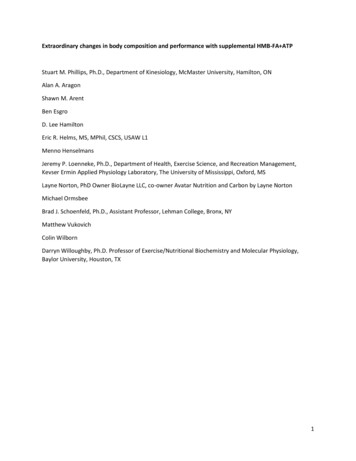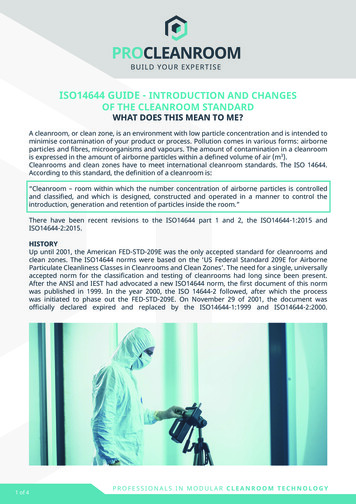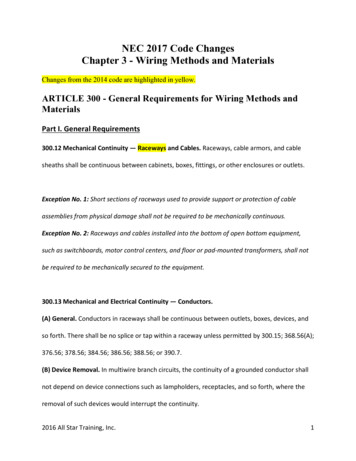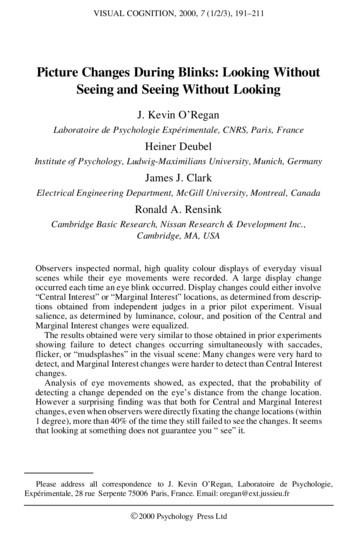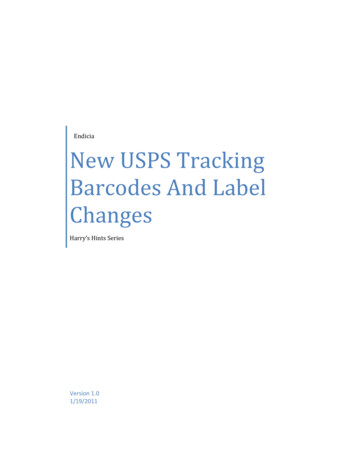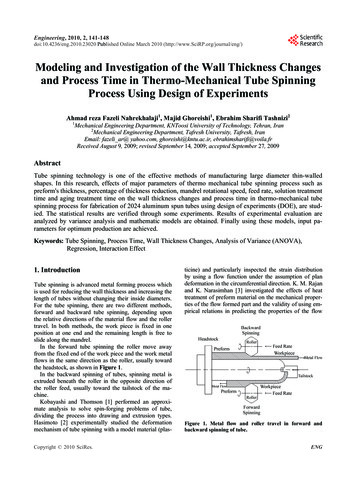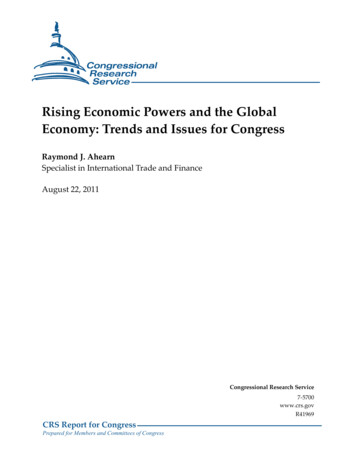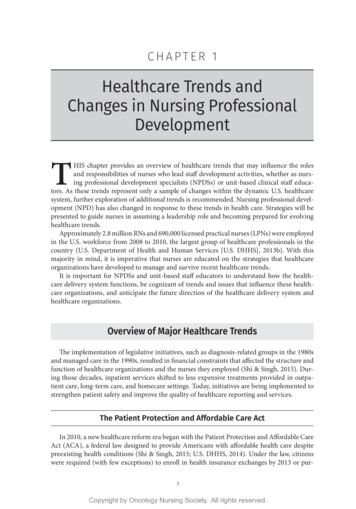
Transcription
CHAPTER 1Healthcare Trends andChanges in Nursing ProfessionalDevelopmentTHIS chapter provides an overview of healthcare trends that may influence the rolesand responsibilities of nurses who lead staff development activities, whether as nursing professional development specialists (NPDSs) or unit-based clinical staff educators. As these trends represent only a sample of changes within the dynamic U.S. healthcaresystem, further exploration of additional trends is recommended. Nursing professional development (NPD) has also changed in response to these trends in health care. Strategies will bepresented to guide nurses in assuming a leadership role and becoming prepared for evolvinghealthcare trends.Approximately 2.8 million RNs and 690,000 licensed practical nurses (LPNs) were employedin the U.S. workforce from 2008 to 2010, the largest group of healthcare professionals in thecountry (U.S. Department of Health and Human Services [U.S. DHHS], 2013b). With thismajority in mind, it is imperative that nurses are educated on the strategies that healthcareorganizations have developed to manage and survive recent healthcare trends.It is important for NPDSs and unit-based staff educators to understand how the healthcare delivery system functions, be cognizant of trends and issues that influence these healthcare organizations, and anticipate the future direction of the healthcare delivery system andhealthcare organizations.Overview of Major Healthcare TrendsThe implementation of legislative initiatives, such as diagnosis-related groups in the 1980sand managed care in the 1990s, resulted in financial constraints that affected the structure andfunction of healthcare organizations and the nurses they employed (Shi & Singh, 2015). During those decades, inpatient services shifted to less expensive treatments provided in outpatient care, long-term care, and homecare settings. Today, initiatives are being implemented tostrengthen patient safety and improve the quality of healthcare reporting and services.The Patient Protection and Affordable Care ActIn 2010, a new healthcare reform era began with the Patient Protection and Affordable CareAct (ACA), a federal law designed to provide Americans with affordable health care despitepreexisting health conditions (Shi & Singh, 2015; U.S. DHHS, 2014). Under the law, citizenswere required (with few exceptions) to enroll in health insurance exchanges by 2013 or pur1Copyright by Oncology Nursing Society. All rights reserved.
2Nursing Professional Development for Clinical Educatorschase some form of public or private health insurance by January 1, 2014 (Shi & Singh, 2015).Those who failed to enroll were taxed (Shi & Singh, 2015). Although many individuals haveidentified benefits of ACA, others have cited its negative aspects. ACA offers a wealth of information regarding the direction of health care; however, three particular sections provide significant implications to the nursing profession.Title III, Improving the Quality and Efficiency of Health Care, calls for a transformation ofthe U.S. healthcare delivery system to improve quality and safety outcomes (U.S. DHHS, 2015).It includes incentives for nurses and physicians who advance quality outcomes and reducepatient errors and harm. It also calls for more attention in designing new patient care modelsand ensuring quality care for seniors under Medicare.Title V, Health Care Workforce, aims to increase the number of healthcare providers engagedin primary care and public health services through recruitment and retention strategies, suchas scholarships and loan repayment programs for education and training (U.S. DHHS, 2015). Itaddresses the national nursing shortage by increasing the number of nurses and also increasesthe number of physicians, physician assistants, mental health workers, and dentists.Title VI, Transparency and Program Integrity, promotes healthcare environments thatembrace the transparent exchange and integrity of information, enabling the public to makeinformed healthcare decisions (U.S. DHHS, 2015). In particular, it promotes safe, quality carein long-term care settings through the use of employee background checks, continuous qualityimprovement initiatives, and ongoing staff safety education and training. Attention is paid toresearch focused on patient-centered outcomes and controlling waste, fraud, and abuse (U.S.DHHS, 2015).Institute of Medicine RecommendationsThe Institute of Medicine (IOM) has played an instrumental role over the past two decadesin response to the changes in the U.S. healthcare system, the state of healthcare delivery, andthe need to prepare competent healthcare professionals. IOM has issued several landmarkreports to guide the future of health care in America. To Err Is Human: Building a Safer HealthSystem focused on patient safety and offered healthcare system strategies to decrease the number of preventable medical errors (IOM, 1999). Crossing the Quality Chasm: A New Health System for the 21st Century recommended a redesign of the U.S. healthcare system based on ananalysis of the quality gap, expectations to support patient and clinician relationships, andways to foster evidence-based practice (EBP) and stronger information systems (IOM, 2001).The six areas cited as needing improvements were safety, effectiveness, patient-centeredness,timeliness, efficiency, and equity (Berwick, 2012).In 2004, IOM issued Keeping Patients Safe: Transforming the Work Environment of Nurses,which recommended remedies to patient safety threats associated with the working environment. This report also offered an action plan on work issues, such as nurse staffing levels, workhours, and mandatory overtime.From a collaboration with the Robert Wood Johnson Foundation (RWJF), IOM’s 2010landmark report The Future of Nursing: Leading Change, Advancing Health was an effort to“assess and respond to the need to transform the nursing profession” (p. xii) and prepare anursing workforce suited to meet current and future healthcare changes. The report conveyedfour key points (IOM, 2010, p. 4): Nurses should practice to the full extent of their education and training. Nurses should achieve higher levels of education and training through animproved education system that promotes seamless academic progression.Copyright by Oncology Nursing Society. All rights reserved.
Chapter 1. Healthcare Trends and Changes in Nursing Professional Development3 Nurses should be full partners, with physicians and other healthcare professionals, in redesigning health care in the United States. Effective workforce planning and policy-making require better data collection and an improved information infrastructure.Figure 1-1 outlines IOM’s eight recommendations for preparing nurses for the future andovercoming barriers within work environments.Consistent with its efforts toward promoting quality health care for Americans, IOM turnedits attention to the growing number of cancer survivors and the current state of care availableto them (IOM, 2013a). In Improving the Quality of Cancer Care: Addressing the Challenges of anAging Population, IOM noted a substantial increase in the number of older adults being diagnosed with cancer during an era of healthcare workforce shortages (IOM, 2013b). In 2013,IOM published Delivering High-Quality Cancer Care: Charting a New Course for a System inCrisis, its comprehensive investigation of cancer care in the United States. IOM made recommendations essential to improving the current cancer care delivery system and quality patientoutcomes (IOM, 2013a). Central to these changes, it proposed a conceptual framework of sixelements aimed to improve the quality of care across the cancer continuum (IOM, 2013a, pp.3–5): Engaged patients An adequately staffed, trained, and coordinated workforce Evidence-based cancer care A learning healthcare information technology (IT) system for cancer Translation of evidence into clinical practice, quality measurement, andperformance improvement Accessible, affordable cancer care.IOM’s recommendations provide oncology nurses with opportunities to assume leadershiproles in changing current and future cancer care services within their work settings (Becze,2014; Ferrell, McCabe, & Levit, 2013). NPDSs involved in cancer care education should reviewthese recommendations with nurses and develop proactive strategies to positively influencecancer care.In addition to IOM’s cancer care reports, oncology nurses and NPDSs need to understandthe national accreditation standards for specialty services, such as those found in the American College of Surgeons Commission on Cancer’s (ACS CoC’s) Cancer Program Standards2012: Ensuring Patient-Centered Care. According to these standards, “Oncology nursing care isprovided by nurses with specialized knowledge and skills” (ACS CoC, 2012, p. 66). Oncologynursing education resources, such as courses available through the Oncology Nursing Society (ONS), are referenced as optimal means for preparing nurses caring for patients with canFigure 1-1. Institute of Medicine Recommendations on the Future of Nursing1.2.3.4.5.6.7.8.Remove scope-of-practice barriers.Expand opportunities for nurses to lead and diffuse collaborative improvement efforts.Implement nurse residency programs.Increase the proportion of nurses with a baccalaureate degree to 80% by 2020.Double the number of nurses with a doctorate by 2020.Ensure that nurses engage in lifelong learning.Prepare and enable nurses to lead change to advance health.Build an infrastructure for the collection and analysis of interprofessional healthcare workforcedata.Note. Based on information from Institute of Medicine, 2010.Copyright by Oncology Nursing Society. All rights reserved.
4Nursing Professional Development for Clinical Educatorscer. Certification in oncology nursing within these organizations is not required but is highlyencouraged (ACS CoC, 2012). The credentials and competencies of cancer care nurses mustbe evaluated on a yearly basis and recorded according to policy (ACS CoC, 2012). Specific criteria for measuring an organization’s compliance with these standards are also outlined in theaccreditation manual.Transforming Nursing EducationAnother landmark report on the future of nursing, Educating Nurses: A Call for RadicalTransformation (Benner, Sutphen, Leonard, & Day, 2010), called for a change in how nursesare prepared to meet current and future healthcare demands, claiming that nurses are undereducated to meet the complex challenges in clinical practice and academic settings and areunable to keep up with fast-paced changes in practice, resulting in an education–practice gap.Several recommendations for redesigning nursing education are provided in the report, calling for changes in teaching and learning practices and policy.Patient Safety in Practice and EducationIn addition to IOM and ACA efforts to strengthen patient safety and the quality of healthcare reporting and services, other national groups have implemented related initiatives. TheJoint Commission, an organization that accredits and certifies healthcare organizations, strivesto improve health care for consumers through evaluation of quality and safety standards (JointCommission, n.d.-a). Nearly two decades ago it created the Sentinel Event Policy, aimed toassist hospitals when they encounter an event that affects a patient (Joint Commission, n.d.-c).A sentinel event is a “safety event not primarily related to the natural course of the patient’s illness or underlying condition that reaches a patient and results in any of the following: death,permanent harm, or severe temporary harm with an intervention required to sustain life”(Joint Commission, n.d.-c, para. 2).In 2002, the Joint Commission initiated its National Patient Safety Goals (NPSGs), whichfocused on solving healthcare safety problems (Joint Commission, n.d.-b). These safety issuesincluded several nursing responsibilities, such as safe medication administration, communication, clinical alarm safety, healthcare-associated infections, and patient identification.Although the Joint Commission identifies new safety priorities each year, prior NPSGs oftenremain as expectations for successful accreditation (Gorbunoff & Kummeth, 2014).In an effort to prepare future nurses in meeting national quality and safety standards, theRWJF-funded Quality and Safety Education for Nurses (QSEN) Initiative established competencies expected of students enrolled in prelicensure RN and graduate nursing programs (QSENInstitute, 2012). Created in 2005, QSEN competencies align with those of IOM (2003) and comprise six qualities of knowledge, skills, and attitudes: patient-centered care, teamwork and collaboration, EBP, quality improvement, safety, and informatics (QSEN Institute, 2014). The QSENInstitute also provides teaching resources and ongoing faculty development programs.Current and Future Nursing WorkforceThe nursing shortage (American Association of Colleges of Nursing [AACN], 2014b) hascompounded current initiatives and will influence future ones. Although the recent reces-Copyright by Oncology Nursing Society. All rights reserved.
Chapter 1. Healthcare Trends and Changes in Nursing Professional Development5sion led to a slight increase in RN employment within the U.S. (AACN, 2014b), a 2009 studyprojected that hospitals may expect a “shortfall of RNs developing around 2018 and growing to about 260,000 by 2025” (Buerhaus, Auerbach, & Staiger, 2009, p. w663) unless nursingschools are able to increase their capacity to produce nurses. More recent workforce reportspredicted the shortage to continue into 2030, with the greatest need for nurses in the southernand western regions of the country (Juraschek, Zhang, Ranganathan, & Lin, 2012). An agingworkforce is among the major reasons for the nursing shortage (Buerhaus et al., 2009; Juraschek et al., 2012). A similar shortage in qualified nursing faculty also has implication
nursing workforce suited to meet current and future healthcare changes. The report conveyed four key points (IOM, 2010, p. 4): Nurses should practice to the full extent of their education and training. Nurses should achieve higher levels of education and training through an improved education system that promotes seamless academic progression.File Size: 709KBPage Count: 16


